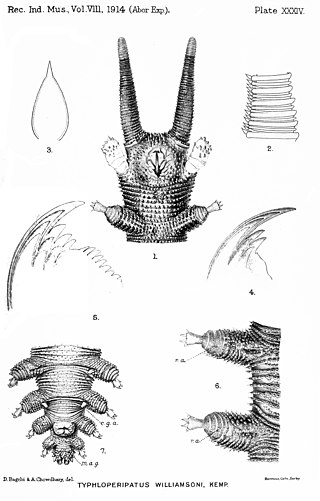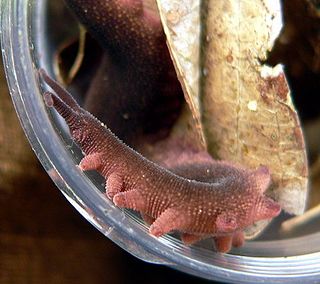
Catbus is a fictional supporting character in the Studio Ghibli film My Neighbor Totoro, directed by Hayao Miyazaki. It is a large, grinning, twelve-legged cat with a large bushy tail and a hollow body that serves as a bus, with windows and seats covered with fur. The character's popularity has led to a spinoff short film, toys for children, an art car, and an exhibit in the Ghibli Museum. Catbus is believed to be based on the Japanese bakeneko, an ancient urban legend where cats that grow old learn to shapeshift. In the original Japanese version of My Neighbor Totoro, Catbus is voiced by Naoki Tatsuta, whilst in the Disney English release, Catbus is voiced by Frank Welker, and by voice actor Carl Macek in the Streamline Pictures release.
Speleoperipatus is a monospecific genus of velvet worm in the Peripatidae family, containing the single species Speleoperipatus spelaeus. This species is a pale greenish yellow, almost white, with 22 or 23 pairs of legs and no eyes. Specimens range from 27 mm to 34 mm in length. The minimum number of leg pairs found in this species (22) is also the minimum number found in the neotropical Peripatidae. This velvet worm is viviparous, with mothers supplying nourishment to their embryos through a placenta.

Typhloperipatus is a genus of velvet worm in the family Peripatidae, containing the sole species Typhloperipatus williamsoni. This genus is notable for containing the only species in the phylum Onychophora found in South Asia. This species is also striking in that this velvet worm shows no trace of eyes.

Peripatidae is a family of velvet worms. The oldest putative representatives of the family herald from Burmese amber dated to the mid-Cretaceous, around 100 million years ago, with representatives from Dominican and Baltic amber attesting to a broader distribution in the Palaeogene / Neogene; molecular variability suggests that the family's crown group may have arisen in the early Mesozoic.

Eoperipatus is a Southeast Asian genus of velvet worm in the family Peripatidae. The number of legs in this genus varies within species as well as among species and ranges from 22 pairs to 25 pairs. This genus exhibits lecithotrophic ovoviviparity; that is, mothers in this genus retain yolky eggs in their uteri.
Heteroperipatus is a genus of Central American velvet worms in the Peripatidae family. The number of legs in this genus varies within species as well as among species and ranges from 26 pairs to 32 pairs. This genus is viviparous, with mothers supplying nourishment to their embryos through a placenta.
Cerradopatus is a monospecific genus of velvet worm containing the single species Cerradopatus sucuriuensis. Males of this species have 28 or 29 pairs of legs; females have 30 to 32. This species is native to the Brazilian savannah. This species is viviparous, with mothers supplying nourishment to their embryos through a placenta.
Metaperipatus is a genus of velvet worms in the family Peripatopsidae that contains two species found in Chile, including Metaperipatus inae. This genus was created by the American zoologist Austin Hobart Clark in 1913 to contain the type species, M. blainvillei. Authorities believe M. blainvillei is a species complex, however, and some consider M. blainvillei a nomen dubium.
Epiperipatus imthurni is a species of velvet worm in the family Peripatidae. This species ranges from light orange or yellowish brown to a dark brown on its dorsal surface; the ventral surface is a lighter orangeish shade of the same color. The type locality is in Guyana. No males have been recorded from this species. Females can reach a large size, up to 2.25 g in weight, and range from 25 mm up to 96 mm in length. They have 29 to 32 pairs of legs, usually 30 or 31. Females from Trinidad were shown to reproduce via parthenogenesis; the only velvet worm known to do so.
Eoperipatus butleri is a Malaysian species of velvet worm in the Peripatidae family.
Eoperipatus weldoni is a species of velvet worm in the Peripatidae family. This velvet worm is dark brown with pale spots and a darker line running down the middle of its back. The ventral surface is yellowish grey with small spots of brown. This species has 23 to 25 pairs of legs and can reach 65 mm in length, but the average specimen is 58 mm in length. The type locality is in West Malaysia.
Epiperipatus acacioi is a species of velvet worm in the Peripatidae family. This species is dark purple with a bilaterally symmetric pattern on its dorsal surface and ranges from 13 mm to 47 mm in length. Males of this species have 24 to 27 pairs of legs, usually 25 or 26; females have 26 to 30, usually 27 or 28. The type locality is in Minas Gerais, Brazil.
Epiperipatus adenocryptus is a species of velvet worm in the Peripatidae family. This species is brown with a series of light brown arcs on each side forming a series of circles down its dorsal surface. Males of this species have 26 or 27 pairs of legs, usually 27; females have 28 to 30, usually 29. The type locality is in Minas Gerais, Brazil.
Epiperipatus barbouri is a species of velvet worm in the Peripatidae family. This species is a dark purple, almost black, without any pattern on its dorsal surface. The ventral surface is much lighter and purplish pink. Females of this species have 30 to 34 pairs of legs. The type locality is in Grenada.
Epiperipatus vespucci is a species of velvet worm in the Peripatidae family. This species is dark with a complex pattern on its dorsal surface. The male of this species has 30 pairs of legs; females have 33 or 34. The type locality is in Colombia.
Epiperipatus machadoi is a species of velvet worm in the Peripatidae family. This species is dark brown with a series of light brown arcs on each side forming circles down its back and ranges from 20 mm to 66 mm in length. Males of this species have 27 to 29 pairs of legs, usually 28; females have 28 to 31, usually 31. The type locality is in Minas Gerais, Brazil.

Tasmanipatus barretti, the giant velvet worm, is a species of velvet worm in the Peripatopsidae family. It is the sole species in the genus Tasmanipatus and is ovoviviparous.
Peripatus dominicae is a species of velvet worm in the Peripatidae family. The type locality for this species is on the Caribbean island of Dominica. Although Stewart Peck introduced the name Peripatus dominicae dominicae in 1975 to distinguish the original species from other subspecies then assigned to P. dominicae, authorities now deem these subspecies to be separate species in light of the significant distances between their type localities.
Peripatopsis sedgwicki is a species of velvet worm in the Peripatopsidae family. Also known as the Tsitsikamma velvet worm, this species has a narrow geographic distribution in South Africa but is especially abundant in the indigenous forest of the Tsitsikamma mountains. Recent phylogenetic analysis suggests that Peripatopsis sedgwicki is a species complex that contains three clades, each with a distinct geographic distribution, including at least one clade that may represent a novel species.
Ooperipatellus nickmayeri is a species of oviparous velvet worm in the family Peripatopsidae. This species is larger than any other in the genus Ooperipatellus. With a body size exceeding 60 mm in females and 30 mm in males, these velvet worms can be more than twice as long as other species of this genus.





